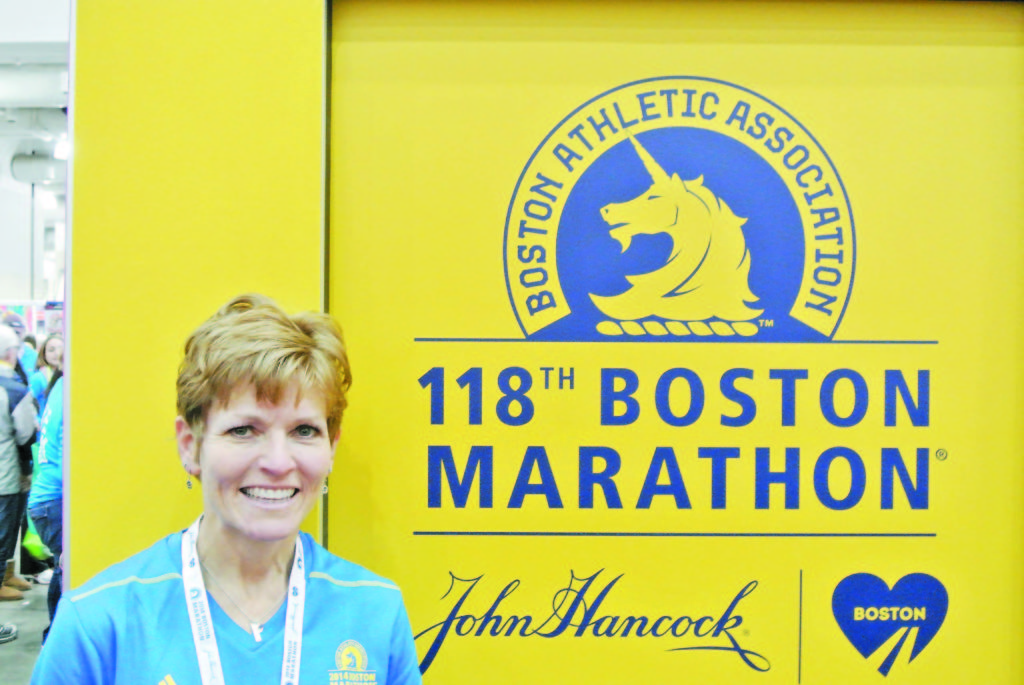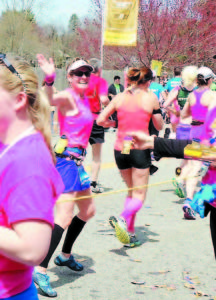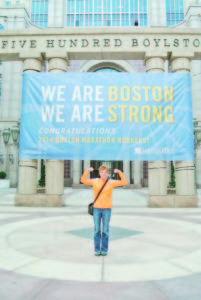
Editor’s note: Katie Cartwright, a Corona del Sol and University of California, Berkeley, graduate who now lives and works in San Francisco, competes Sunday, April 22 in the London Marathon.
Learning of Katie’s plans, and noting the recently completed Boston Marathon, Amy Garza, a graphic design specialist for the Tempe Elementary School District, said the two back-to-back events brought to mind the tragic April 15, 2013, bombing in Boston. Garza ran in the same race a year later.
The following commentary relates some of Garza’s memories and what she has experienced in the event’s five-year aftermath.
By Amy Garza
Any time a tragic event happens, you remember where you were when you heard the news. That’s how it was for me and the Boston Marathon bombing. I was eating lunch with my husband, Noel, on April 15, 2013.
We saw the news feed on our smartphones that a bomb had just gone off right near the finish line. Noel immediately called his office because one of their coworkers, Jeffrey Breese, was among the competitors. His office couldn’t reach him. Turns out, he hadn’t finished the race yet, and once the bombs went off, officials immediately detoured the remaining runners far away from the finish line. Thousands of racers weren’t aware of what had just happened.
Many don’t run with their cell phones, so Jeffrey had no way of reaching his wife, Elena, who was in the grandstands near the finish line. Later he found out she witnessed one of the bombs going off, and it’s something she will never forget.
Breese and more than 5,600 other runners never got to cross the finish line on Boylston Street that year.
Hearing about his experience and watching the television coverage sparked something inside me. It didn’t make me scared to run it. It actually drove me to want to run it even more, mainly as a tribute to all the victims of that tragic day: for the 3 lives that were lost, the more than 260 wounded; for the 16 who lost limbs, and for the countless others who had emotional scars you can’t see.
Running a marathon is physically and emotionally challenging. It’s a stress on the body. You don’t just decide one day you are going to sign up for a 26.2-mile race and run it the next day. Months of training is involved—months of running 35 or more miles per week, spending four hours or more running on long run days.
Commitment to running even when you are tired and spending time away from your family.
The Boston Marathon isn’t just any marathon. It is the oldest annual event of its kind in history. For many long distance runners, it’s the “bucket list” marathon. It’s a race you have to qualify for, which means you have to have completed a BAA-sanctioned marathon within the qualifying times for your age and gender by the cutoff date.
And that’s not always enough.
 I had a qualifying time that was fast enough by the standards. But that doesn’t guarantee entry into the race. You still have to try to register online the minute it opens, because the race is capped at a certain number of entrants, about 30,000, although it varies each year. It’s first-come, first-served, in a way, with the people with the fastest qualifying times vying for the first spots. You don’t really know if you’re in until you get your acceptance packet in the mail.
I had a qualifying time that was fast enough by the standards. But that doesn’t guarantee entry into the race. You still have to try to register online the minute it opens, because the race is capped at a certain number of entrants, about 30,000, although it varies each year. It’s first-come, first-served, in a way, with the people with the fastest qualifying times vying for the first spots. You don’t really know if you’re in until you get your acceptance packet in the mail.
I don’t remember exactly what day it was, but I do remember checking the mail every day after I registered. One day, I told my husband, “I got in!” We soon made our arrangements and decided to make a vacation out of it. I thought to myself, “This could be a once-in-a-lifetime chance for me.”
I had such an unforgettable experience, and these are just some of the highlights.
Once there, we soaked it all in. One of the first stops was to check out Boylston Street and that famous blue and yellow finish line. There were memorials right at the two bombing sites, with the names of the victims who lost their lives. Seeing them was a very emotional experience and reminded me why I was there, to run for those who couldn’t.
At the Expo on race weekend, I took a photo with and got an autograph from Marathon Woman author and women’s rights activist Kathrine Switzer, the first woman who ever ran the Boston Marathon. Switzer paved the way for female athletes around the world, proving that a woman can do pretty much anything a man can do. She ran her first Boston Marathon in 1967, signing up as K.V. Switzer, and was nearly dragged off the course by race officials when they discovered a female was running the race. She persevered and finished that marathon in 4:20 and refers to herself as “261 Fearless” because 261 was her bib number for that race, and she wasn’t afraid of the man who nearly tackled her, trying to get her out of the race. Instead, she is thankful for what transpired because it motivated her to stay strong and finish that race, the race that changed her life and the lives of female runners and athletes and countless other women she inspires.
Also the Expo, I took a picture with the Hoyts, father Richard Eugene “Dick” Hoyt and son Richard Eugene “Rick” Hoyt, Jr., who has cerebral palsy. This inspirational father-son team is the true picture of devotion, so I had to buy their book Devoted: The Story of a Father’s Love for His Son, written by Dick Hoyt, because I was so intrigued by their story. Dick faithfully pushes his son in races in a special wheelchair and this was their 32nd and last Boston Marathon.
The day before the Boston Marathon in 2014 was Easter Sunday, and the Old South Church handed out handknit blue and yellow scarves to 7,000 runners, all with a safety-pinned note signed by the knitter as a message of hope. The yellow and blue tag said, “This scarf is interwoven with love and courage,” and was signed by the knitter. A church member placed the scarf over my head, and I proudly wore it around my neck almost the whole time I was in Boston, as a remembrance of those who were affected by that horrific day a year before.
 During our time in Boston before the race, we experienced all the history that is Boston, visiting the Freedom Trail, Boston Common, Harvard University, Faneuil Hall Marketplace, and Cheers Bar, catching a Boston Red Sox game at Fenway Park, taking a tour of Samuel Adams Brewing Company, sampling the local seafood, walking along the beach, and more! These things were all amazing, but seeing the memorials made of blue and yellow ribbons, tennis shoes, flags, and “Boston Strong” signs, and people who were missing limbs really hit home with me. I kept those images in my mind while I walked the streets of Boston and would do the same during the race.
During our time in Boston before the race, we experienced all the history that is Boston, visiting the Freedom Trail, Boston Common, Harvard University, Faneuil Hall Marketplace, and Cheers Bar, catching a Boston Red Sox game at Fenway Park, taking a tour of Samuel Adams Brewing Company, sampling the local seafood, walking along the beach, and more! These things were all amazing, but seeing the memorials made of blue and yellow ribbons, tennis shoes, flags, and “Boston Strong” signs, and people who were missing limbs really hit home with me. I kept those images in my mind while I walked the streets of Boston and would do the same during the race.
It was now time to get prepared for race morning. It has become a pre-race ritual, like it is for so many runners. I charged my GPS watch and my iPod, laid out my clothes, my running belt, and my race bib, selected my energy gel, and got my breakfast ready. I brushed my teeth and crawled into bed.
While I was tossing and turning in bed the night before the big day, my husband, Noel, rode the course on his bike at the annual midnight marathon bike ride. An avid cyclist, he had just found out about this epic ride a day or two after we got to Boston. “What a great way to experience the race you are about to run without actually running it myself!” he thought. “I wanted to see what ‘Heartbreak Hill’ was really like and see all places along the course you were going to see.”
Since he wasn’t planning on participating in any kind of bicycling event, he didn’t have a bicycle or a helmet or a light or any cycling equipment with him, so he borrowed a bike from a friend of a friend and bought some supplies at a local store. He did the ride and came back during the night and was still able to be up and ready to head to the athlete buses with me. Even with very little sleep, he had enough energy to jump on the Boston Transit Subway system, or the “T,” to cheer me on at a few spots along the way.
The Boston Marathon is a point-to-point race, which means you have to take a bus to the start line. I boarded the bus with plenty of time to make it to the start in Hopkinton and walk to my wave and corral. Thankfully, though, I ate a peanut butter and jelly sandwich and a bar on the bus, because I had no idea my bus would miss the exit and have to turn around and backtrack to the start. People on the bus were chattering about the bus missing the exit and we all started worrying that we were going to miss our start time. Forget having time to eat or use the restroom at athlete’s village near the start, because many panicked people scurried off the bus and ran to the side of the road to use the restroom and just ran to the start.
I took the time to stand in line for a port-a-potty, but there was no time for anything else. I had to hurry my way closer to the start. If that wasn’t enough, I couldn’t get my GPS watch to work, so I called my husband in a panic. I had watched my wave and corral pass me by trying to figure out what to do. He told me to just go, so I did. It was too late to catch my pacer, the person who maintains a consistent pace in order to help you finish a race in the time you want to. I knew I would have no idea what my time or pace was, so I just decided to run my race naturally – how I had trained – and just take it all in and enjoy it.
I remembered that a friend had told me that there are so many spectators along the course to inspire you, and she was right. There was rarely a point on the sidelines that didn’t have people cheering you on or offering “high fives.” And knowing my husband would be at a few points, I kept my eye out for him, and that gave me a little jolt of adrenaline every time I saw him. My friend was right. There were so many fans clapping, cheering, and shaking cow bells, almost the whole way, and that was so motivating for me.
At one point during the race, I ran behind “Team Hoyt” for a little while, just admiring their demonstration of determination and devotion. This father-son team has competed in numerous marathons, Ironman Triathlons, and other athletic events totalling 1,130 over the years since 1977. This team’s determination, and especially Dick’s devotion to his son is absolutely awe-inspiring, and as I ran alongside them and gave them a thumbs up, it brought tears to my eyes and a lump in my throat.
The race felt so good, like no other race I had run before. Heartbreak Hill didn’t seem as bad as the name implies. Every time it felt a little difficult, I just thought about all the people I was running for.
I saw my husband one last time toward the end of the race, right before I turned the corner to head down Boylston Street. That stretch of the race is so incredible, lined with flags from all around the world. It reminds you that no matter where you are from, we are all running the same race. We all have one goal in mind – to finish our race.
As I crossed the finish line, a flood of emotions came over me, and I realized that I had just finished the Boston Marathon. Despite not knowing what my pace was during the race, I somehow finished only about three minutes slower than my qualifying time, in 3:50:18.
Four years later, April 16, 2018 marked the 122nd running of the Boston Marathon – the fifth anniversary of the Boston Marathon bombing. It was the day Jeffrey Breese finally crossed that finish line and completed his Boston Marathon.

